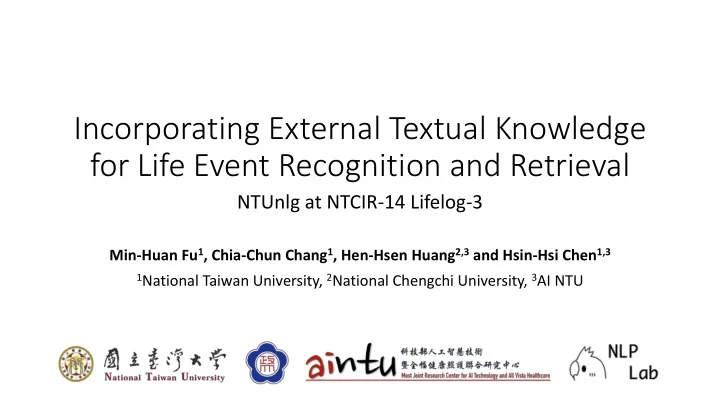

Incorporating External Textual Knowledge for Life Event Recognition and Retrieval NTUnlg at NTCIR-14 Lifelog-3 Min-Huan Fu 1 , Chia-Chun Chang 1 , Hen-Hsen Huang 2,3 and Hsin-Hsi Chen 1,3 1 National Taiwan University, 2 National Chengchi University, 3 AI NTU
Introduction • Lifelog semantic access task (LSAT) • Retrieve specific moments in a lifelogger's life (a known-item search task) • Example: Find the moment when u1 was eating ice cream beside the sea. Find the moment when u1 was eating fast food alone in a restaurant. • Lifelog activity detection task (LADT) • Detect and recognize life event from 16 types of daily activities (a multi-label classification task) • Example: traveling, face-to-face interaction, using a computer, cooking, eating, relaxing, house working, reading, socializing, shopping …
Introduction (cont’d) • A huge challenge for multimedia lifelog access: the semantic gap between visual and textual domains • Lifelogs are stored as multimedia archives (visual domain) • We want to retrieve life events using verbal expressions (textual domain) • Intuitively we may exploit CV models to obtain visual concepts for lifelog images, but there is still gap between topics and concepts • We incorporate word embeddings as external textual knowledge for both subtasks; specifically, we try to: • Suggest concept words related to life event topics for LSAT task • Enrich the training data of supervised learning for LADT task
Preprocessing • Besides the official concepts, each image is associated with additional visual concepts extracted by Google Cloud Vision API • Lens calibration is performed on all images to prevent erroneous outputs from advanced CV models • We further filter out images with low quality based on blurriness and color diversity detection • We use the following visual concepts in this work: • Place attributes and categories from PlaceCNN (official) • Visual labels and objects from Google API
LSAT Framework
LSAT framework (cont’d) • In our retrieval framework, lifelog images are represented as short documents consisting of associated concept words • For each word in the event topic, the retrieval system suggests a list of semantically similar concept words to the user • Users can select concepts to formulate the query , then our system will perform retrieval with BM25 ranking • In the refinement stage, users can manually remove irrelevant images
LSAT result • Our interactive approach largely outperforms the automatic baseline that uses top-10 related concepts to all topic words as query • We observed the total number of relevant documents retrieved has slightly decreased after the user refinement • This may result from that the user of our system is not the lifelogger himself, and possibly make wrong deletions of the relevant retrieval results Run ID mAP P@10 RelRet Run01: Automatic query expansion 0.0632 0.2375 293 Run02: Interactively selected query* 0.1108 0.3750 464 Run03: Selected query + refinement* 0.1657 0.6833 407 * We use the same queries for Run02 & Run03; the average interaction time of Run03 for each topic is 159.5 s
LADT approach • We address LADT subtask as multi-label classification and manually annotate partial dataset as training data • Our proposed DNN model takes as input the visual features extracted by VGG-19 (512D) and the textual features encoded by GloVe (300D) • One challenge to include unordered set of vectors as NN’s input is that common network structures for ordered text are hardly applicable • We adopt a similar structure to the Deep Averaging Network (DAN) to deal with the unordered input, but use weighted average instead
… … LADT approach ( cont’d) … … … • We include semantic relatedness as the weighting factor • Concept that is more related to other VGG Image k k concepts associated to the same image d is considered more important w 0 d B k … sigmoid places w 1 … • We may also measure the relatedness w 9 … k w 0 M objects between concept words and activity w 1 … k w 9 description instead w 0 R k labels w 1 … • Self-feedback: the model can also w 9 sum over rows weighting a accept its prediction in previous K time steps as additional input c. Weighted aggregation w/ self-feedback d.
LADT result • The recall score of the model increases when we adopt proper aggregation strategies for concept words, while the precision score does not necessarily increase Model Precision Recall Micro-F1 Image (baseline) 0.7084 0.3606 0.4780 + averaged words 0.7522 0.3840 0.5084 + concept self-correlation - - - + feedback 0.7535 0.4168 0.5367 + concept-description relation 0.7261 0.4023 0.5177 + feedback 0.7307 0.4332 0.5439
Conclusion • For life moment retrieval, we introduce external textual knowledge to reduce the semantic gap between textual queries and visual concepts extracted by CV models • For activity detection and recognition, we incorporate textual features aggregated in an unordered fashion to enrich the training data for supervised DNN models
Thank you!
Recommend
More recommend